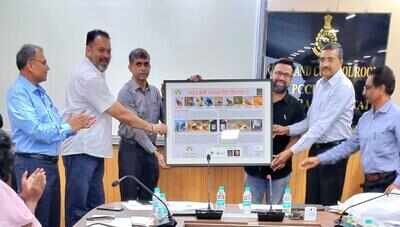- News
- City News
- nagpur News
- Declare Maha a safe zone for vultures, BNHS urges govt
Declare Maha a safe zone for vultures, BNHS urges govt

BNHS and Corbett Foundation released a banner on Friday
Nagpur: On the eve of International Vulture Conservation Awareness Day (on Saturday), the Maharashtra government was urged to declare the state as a ‘vulture safe zone’ so as to aid the protection and conservation efforts of the prey birds.
The move has been advocated by the country’s oldest wildlife and biodiversity organization Bombay Natural History Society (BNHS). Globally, the first Saturday of September is observed as International Vulture Conservation Awareness Day.
On this occasion, BNHS honorary secretary Kishor Rithe has written to Maharashtra forest minister Sudhir Mungantiwar, chief wildlife warden Sunil Limaye and principal secretaries for animal husbandry and forest departments to declare the state as a safe zone for vultures, that are on the verge of extinction.
To celebrate the occasion, BNHS and Corbett Foundation released a banner on Friday to raise awareness. It was released by principal secretary (forest) Venugopal Reddy, PCCF (HoFF) YLP Rao and other officials at Van Bhavan in Nagpur. The poster displays the use of which veterinary drugs that need to be stopped and alternate drugs to be used.
Vultures used to be common in rural Maharashtra. However, except for some parts of Melghat, Pench, Nashik and Gadchiroli, vultures have disappeared from the state.
Vultures find their place in religious texts (Puranas) and were mentioned as Sampati and Jatayu. In Ramayana, it is mentioned that Jatayu risked its life to save Sita from Ravana.
These prey birds feed on the carcasses of animals and hence are known as scavengers. In the Parsi community, it is considered that burning or burying the dead causes pollution and harms nature. Hence, it is customary to let vultures feed on these bodies. But due to the disappearance of vultures, the Parsi community is also facing problems.
BNHS director Bivash Pandav said, “BNHS has taken up a vulture research and conservation project in association with the MoEFCC and the state governments of Haryana, Madhya Pradesh and Assam. As part of this initiative, BNHS scientists have studied the causes of decline in vulture population.”
Pandav added, “Diclofenac, a painkiller drug used to treat domestic cattle, was responsible for the death of 99% of the Indian vulture population. Hence, in 2006, the government banned the use of diclofenac. Consequently, a slow rise in the vulture population has now been observed.”
As per recent scientific research, it has been proved that drugs such as aceclofenac, nimesulide and ketoprofen, apart from diclofenac, also affect the vultures' health adversely, Pandav said.
BNHS has urged officers and staff members of the forest and animal husbandry development departments to organize village-level meetings to discuss and take efforts to reduce the use of drugs like diclofenac, aceclofenac, nimesulide, and ketoprofen.
As an alternative, BNHS has said that vets can use meloxicam and tolfenamic acid which have shown no adverse impact on vultures. “BNHS scientists are ready to provide guidance to the forest and livestock departments,” said Rithe.
The move has been advocated by the country’s oldest wildlife and biodiversity organization Bombay Natural History Society (BNHS). Globally, the first Saturday of September is observed as International Vulture Conservation Awareness Day.
On this occasion, BNHS honorary secretary Kishor Rithe has written to Maharashtra forest minister Sudhir Mungantiwar, chief wildlife warden Sunil Limaye and principal secretaries for animal husbandry and forest departments to declare the state as a safe zone for vultures, that are on the verge of extinction.
To celebrate the occasion, BNHS and Corbett Foundation released a banner on Friday to raise awareness. It was released by principal secretary (forest) Venugopal Reddy, PCCF (HoFF) YLP Rao and other officials at Van Bhavan in Nagpur. The poster displays the use of which veterinary drugs that need to be stopped and alternate drugs to be used.
Vultures used to be common in rural Maharashtra. However, except for some parts of Melghat, Pench, Nashik and Gadchiroli, vultures have disappeared from the state.
Vultures find their place in religious texts (Puranas) and were mentioned as Sampati and Jatayu. In Ramayana, it is mentioned that Jatayu risked its life to save Sita from Ravana.
These prey birds feed on the carcasses of animals and hence are known as scavengers. In the Parsi community, it is considered that burning or burying the dead causes pollution and harms nature. Hence, it is customary to let vultures feed on these bodies. But due to the disappearance of vultures, the Parsi community is also facing problems.
BNHS director Bivash Pandav said, “BNHS has taken up a vulture research and conservation project in association with the MoEFCC and the state governments of Haryana, Madhya Pradesh and Assam. As part of this initiative, BNHS scientists have studied the causes of decline in vulture population.”
Pandav added, “Diclofenac, a painkiller drug used to treat domestic cattle, was responsible for the death of 99% of the Indian vulture population. Hence, in 2006, the government banned the use of diclofenac. Consequently, a slow rise in the vulture population has now been observed.”
As per recent scientific research, it has been proved that drugs such as aceclofenac, nimesulide and ketoprofen, apart from diclofenac, also affect the vultures' health adversely, Pandav said.
BNHS has urged officers and staff members of the forest and animal husbandry development departments to organize village-level meetings to discuss and take efforts to reduce the use of drugs like diclofenac, aceclofenac, nimesulide, and ketoprofen.
As an alternative, BNHS has said that vets can use meloxicam and tolfenamic acid which have shown no adverse impact on vultures. “BNHS scientists are ready to provide guidance to the forest and livestock departments,” said Rithe.
FOLLOW US ON SOCIAL MEDIA
FacebookTwitterInstagramKOO APPYOUTUBE
Start a Conversation
end of article









